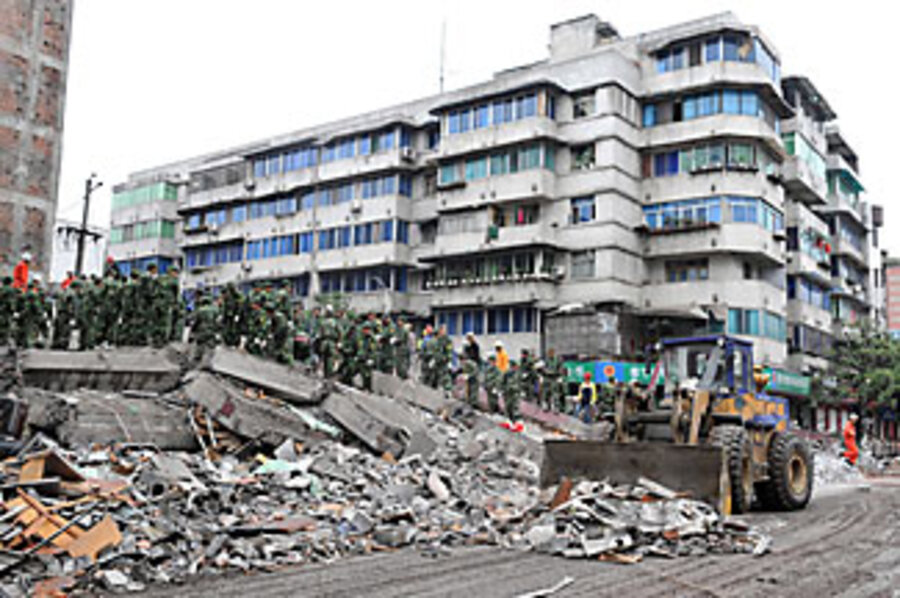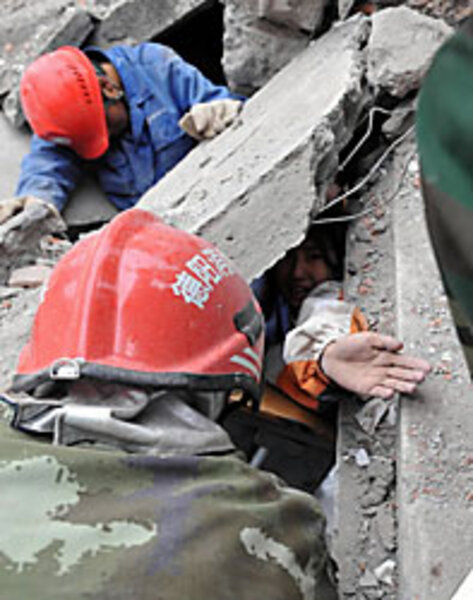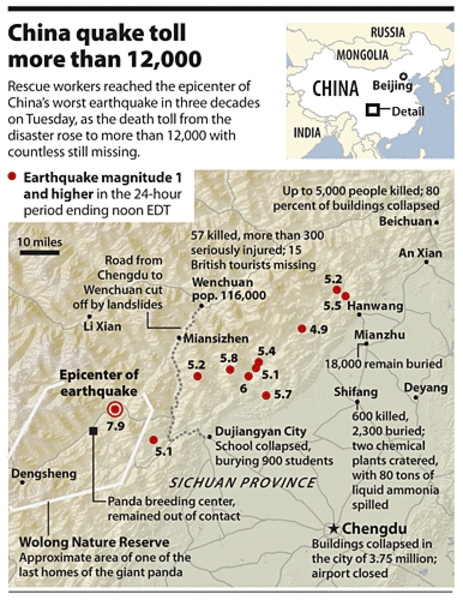China's quake: Why did so many schools collapse?
Loading...
In the wake of Monday's 7.9-magnitude earthquake in China's southwestern province of Sichuan, some international experts are questioning the adequacy of the region's building codes and construction practices.
Juyuan Middle School, about 60 miles from the epicenter, was one of several schools that collapsed Monday. So far rescuers have recovered more than 60 bodies from the school, the official Xinhua News Agency said. But there was little word on the rest of the nearly 900 teenagers who were believed to be trapped under their collapsed school building.
Some students managed to escape, while at least one was pulled out of the wreckage alive Tuesday morning. At least 1,000 students and teachers were killed or missing after another school collapsed in Mianyang city, about 100 miles northeast of the epicenter, Xinhua reported.
Other schools closer to the epicenter also toppled, although specifics were not available because the area was generally inaccessible.
Earthquake engineers say that constructing a building to resist a quake of magnitude 7 or 8 is possible, but is often considered cost prohibitive, adding 7 to 8 percent in costs.
"Earthquake resistance is really more workmanship, than material," Amr Elnashai, director of the Mid-America Earthquake Center at the University of Illinois at Urbana-Champaign, says.
Most seismologists interviewed say that China's quake code is adequate, if not the most up-to-date. "It is well-defined and has all the right features," says Mr. Elnashai.
Earthquake resistance, he notes, does not mean buildings don't sustain damage; they do, but don't collapse.
Schools, he says, are particularly vulnerable because they are often mid-sized buildings, smaller projects for contractors that are paid for the a government bureaucracies. Two recent earthquakes in Indonesia and in Kashmir also resulted in a disproportionate student deaths. "Often school buildings suffer quite a bit," Elnashnai says.
China has "fairly rigorous building codes that have been in place. The problem is implementation of the codes," says Andrew Smeall, an associate with the Asia Society's US-China Center in New York.
Roger Musson, a seismologist at the British Geological Survey in Edinburgh, Scotland, notes that China has good earthquake engineers, but "you can never tell what's going to happen on the spot."
In Turkey's devastating 1999 earthquake, building codes were excellent, but "fly by night builders" had erected buildings using "extremely poor" materials, Mr. Musson says.
"You can buy the building inspector," he says, but "you can't buy off the earthquake."
China has a history of massive earthquakes. About 200 of its cities with a population of over a million are located at risk of magnitude 7 earthquake.
"In this case, where the earthquake occurred, there are a magnitude 4 earthquakes every couple of months," says Lupei Zhu, an associate professor of geophysics, at St. Louis University in Missouri, and a former employee of the China Earthquake Administration, which oversees public awareness and the collection of seismic data for the country.
Bill Murphy, an engineering geologist at the University of Leeds in England, notes that magnitude of the quake is only one measure. "It's not so much the magnitude, but the amount of shaking," he says. "Some of these aftershocks [in Sichuan] have been earthquakes in their own right. That might cause some additional buildings to collapse, especially those that have been weakened by the main earthquake."
A civil engineer at the University of Western Australia in Perth told New Scientist magazine that the buildings in Sichuan weren't built to withstand an earthquake as large as the one that hit.
"The seismic code for the area substantially underestimated the earthquake strength," said Hong Hao. He said that China's earthquake regulations class this province as equivalent to a 7 on the Mercalli intensity scale, which uses historical information to assess risk of damage from earthquakes. That means there's a 10 percent risk of an earthquake occurring every 50 years of an intensity that would cause negligible damaged. Monday's quake was a 10 or 11 on the Mercalli scale.
Xinhua said more than 12,000 had died in Sichuan province alone, but the total number of casualties remained uncertain. In a massive government relief operation, some 20,000 soldiers and police have arrived in the area, with 30,000 more on the way.
"Survivors can hold on for some time. Now it's not time to give up," said Wang Zhenyao, disaster relief official at the Ministry of Civil Affairs in Beijing.
• Material from the Associated Press was used in this report.







